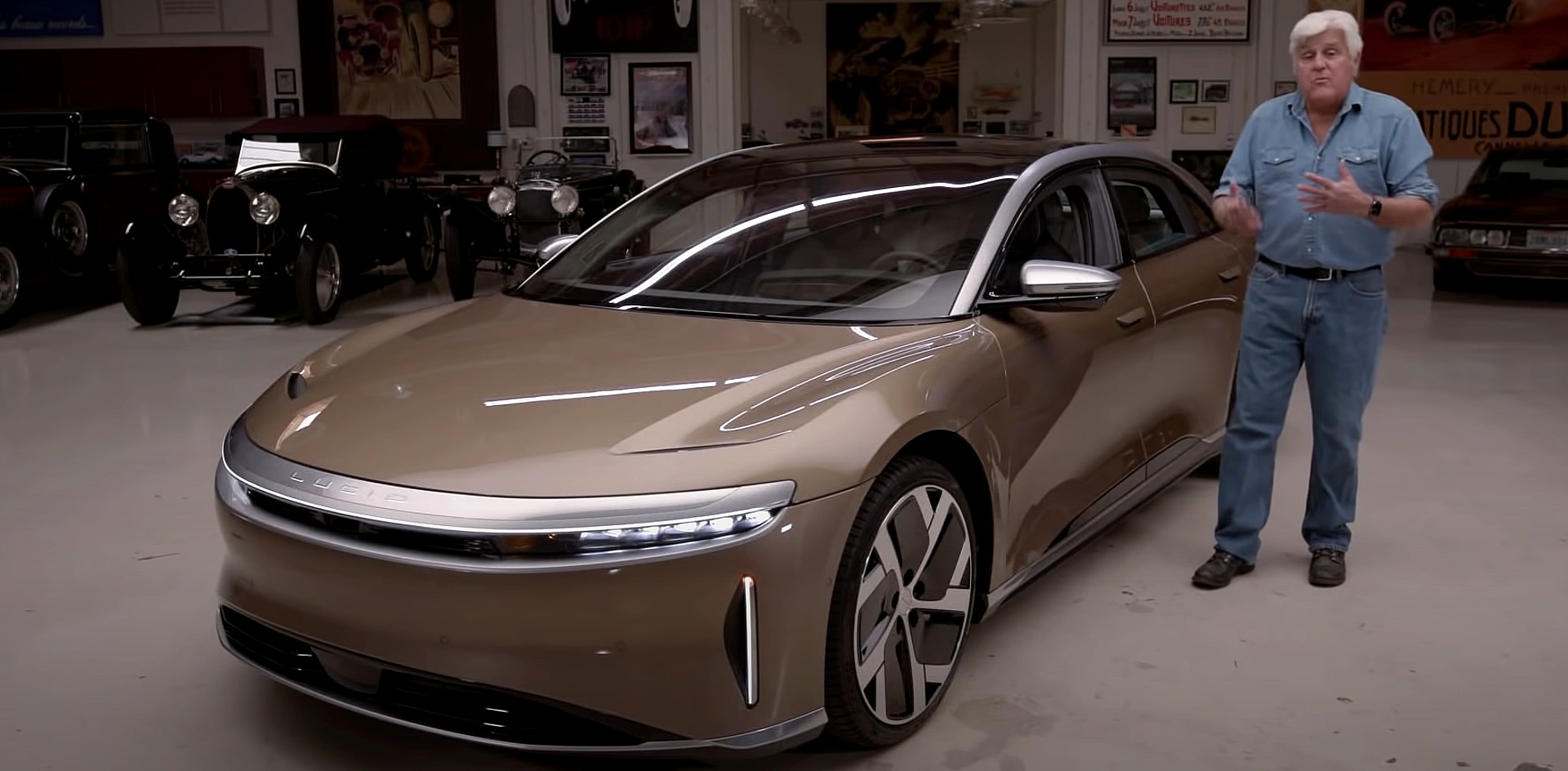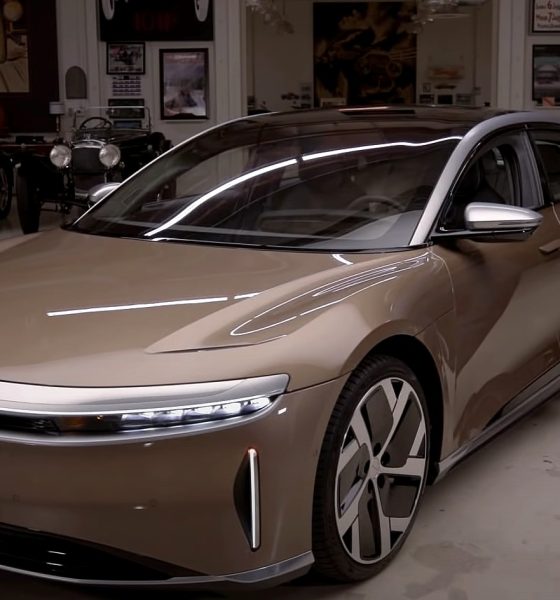

News
Lucid Air Dream Edition gets an in-depth review and speedy test drive at the hands of Jay Leno
Automotive enthusiast Jay Leno is one of the most knowledgeable celebrities in the world when it comes to cars. In recent years, Leno has gotten his hands on some of the best and most exciting vehicles to enter the electric sector, including the Tesla Cybertruck. Despite Leno’s close-knit friendship with Elon Musk, the former late-night TV show host does not show bias when displaying his thirst for the newest and most advanced electric powertrains in the world. Recently, Leno got his hands on the Lucid Air Dream Edition. Following discussions with Senior VP of Design Derek Jenkins and company CEO/CTO Peter Rawlinson, Leno was impressed with what Lucid brought to the table with its first vehicle offering.
Leno’s first thoughts regarding the introduction of the Lucid Air were simple: competition is great for the automotive sector. He notes that Ford and Chevrolet, with their constant need to one-up each other and break competition barriers, made one another better.
It appears to be the same narrative with Tesla and Lucid, two electric car companies fighting for the top spot as the marker of the EV sector’s most luxurious vehicles. Tesla may be slightly more notable due to its fourteen-year history of building electric cars, starting with the Roadster in 2008, a vehicle that Leno still speaks about to this day. However, Lucid has come into the market with a very competitive product that undoubtedly rivals the Tesla Model S Plaid, another vehicle Leno has taken for a spin in the past.
Jenkins showed Leno the finer points of the Lucid Air, detailing the all-aluminum body, a wide-set wheelbase that is more comparable to a Mercedes-Benz S Class than any other vehicle, and the spacious interior that provides a luxurious feel.

Credit: Jay Leno’s Garage | YouTube
Then came the fun part: driving the Lucid Air Dream Edition. Leno has driven many of the world’s most unique vehicles, but his narrative of the Air was definitely positive. He seemed to enjoy the company’s vertical integration with its in-house produced motors, a part that Rawlinson said was designed from the ground up by Lucid engineers. Rawlinson also stated that all of the Air’s EV technology, including the battery pack, were all designed and developed at the company’s Arizona-based facility.
Jay’s synopsis regarding the Air’s performance catalyzed some interesting thoughts regarding Lucid’s development of the vehicle’s most-premier variant. Rawlinson says the Air Dream Edition was not geared for a world-record 0-60 MPH time, although it stands at a lightning-quick 2.4 seconds.
Leno enjoyed hearing the finer points of the Lucid Air from CEO/CTO Peter Rawlinson (Credit: Jay Leno’s Garage | YouTube)
Rawlinson says that Lucid’s goal wasn’t to necessarily have the car launch from a standstill to 60 MPH, but it was designed to give instant torque when the car is already in motion. One example of where the quick acceleration is applicable is on the freeway, Rawlinson said, when trying to overtake a car or fill in a gap. The mid-range punch that the vehicle’s powertrain provides is more than enough acceleration to make each of these maneuvers on a highway easily attainable.
Check out Leno’s full review of the Lucid Air Dream Edition below.

Elon Musk
Elon Musk and Tesla AI Director share insights after empty driver seat Robotaxi rides
The executives’ unoccupied tests hint at the rapid progress of Tesla’s unsupervised Robotaxi efforts.

Tesla CEO Elon Musk and AI Director Ashok Elluswamy celebrated Christmas Eve by sharing personal experiences with Robotaxi vehicles that had no safety monitor or occupant in the driver’s seat. Musk described the system’s “perfect driving” around Austin, while Elluswamy posted video from the back seat, calling it “an amazing experience.”
The executives’ unoccupied tests hint at the rapid progress of Tesla’s unsupervised Robotaxi efforts.
Elon and Ashok’s firsthand Robotaxi insights
Prior to Musk and the Tesla AI Director’s posts, sightings of unmanned Teslas navigating public roads were widely shared on social media. One such vehicle was spotted in Austin, Texas, which Elon Musk acknowleged by stating that “Testing is underway with no occupants in the car.”
Based on his Christmas Eve post, Musk seemed to have tested an unmanned Tesla himself. “A Tesla with no safety monitor in the car and me sitting in the passenger seat took me all around Austin on Sunday with perfect driving,” Musk wrote in his post.
Elluswamy responded with a 2-minute video showing himself in the rear of an unmanned Tesla. The video featured the vehicle’s empty front seats, as well as its smooth handling through real-world traffic. He captioned his video with the words, “It’s an amazing experience!”
Towards Unsupervised operations
During an xAI Hackathon earlier this month, Elon Musk mentioned that Tesla owed be removing Safety Monitors from its Robotaxis in Austin in just three weeks. “Unsupervised is pretty much solved at this point. So there will be Tesla Robotaxis operating in Austin with no one in them. Not even anyone in the passenger seat in about three weeks,” he said. Musk echoed similar estimates at the 2025 Annual Shareholder Meeting and the Q3 2025 earnings call.
Considering the insights that were posted Musk and Elluswamy, it does appear that Tesla is working hard towards operating its Robotaxis with no safety monitors. This is quite impressive considering that the service was launched just earlier this year.
Elon Musk
Starlink passes 9 million active customers just weeks after hitting 8 million
The milestone highlights the accelerating growth of Starlink, which has now been adding over 20,000 new users per day.

SpaceX’s Starlink satellite internet service has continued its rapid global expansion, surpassing 9 million active customers just weeks after crossing the 8 million mark.
The milestone highlights the accelerating growth of Starlink, which has now been adding over 20,000 new users per day.
9 million customers
In a post on X, SpaceX stated that Starlink now serves over 9 million active users across 155 countries, territories, and markets. The company reached 8 million customers in early November, meaning it added roughly 1 million subscribers in under seven weeks, or about 21,275 new users on average per day.
“Starlink is connecting more than 9M active customers with high-speed internet across 155 countries, territories, and many other markets,” Starlink wrote in a post on its official X account. SpaceX President Gwynne Shotwell also celebrated the milestone on X. “A huge thank you to all of our customers and congrats to the Starlink team for such an incredible product,” she wrote.
That growth rate reflects both rising demand for broadband in underserved regions and Starlink’s expanding satellite constellation, which now includes more than 9,000 low-Earth-orbit satellites designed to deliver high-speed, low-latency internet worldwide.
Starlink’s momentum
Starlink’s momentum has been building up. SpaceX reported 4.6 million Starlink customers in December 2024, followed by 7 million by August 2025, and 8 million customers in November. Independent data also suggests Starlink usage is rising sharply, with Cloudflare reporting that global web traffic from Starlink users more than doubled in 2025, as noted in an Insider report.
Starlink’s momentum is increasingly tied to SpaceX’s broader financial outlook. Elon Musk has said the satellite network is “by far” the company’s largest revenue driver, and reports suggest SpaceX may be positioning itself for an initial public offering as soon as next year, with valuations estimated as high as $1.5 trillion. Musk has also suggested in the past that Starlink could have its own IPO in the future.
News
NVIDIA Director of Robotics: Tesla FSD v14 is the first AI to pass the “Physical Turing Test”
After testing FSD v14, Fan stated that his experience with FSD felt magical at first, but it soon started to feel like a routine.

NVIDIA Director of Robotics Jim Fan has praised Tesla’s Full Self-Driving (Supervised) v14 as the first AI to pass what he described as a “Physical Turing Test.”
After testing FSD v14, Fan stated that his experience with FSD felt magical at first, but it soon started to feel like a routine. And just like smartphones today, removing it now would “actively hurt.”
Jim Fan’s hands-on FSD v14 impressions
Fan, a leading researcher in embodied AI who is currently solving Physical AI at NVIDIA and spearheading the company’s Project GR00T initiative, noted that he actually was late to the Tesla game. He was, however, one of the first to try out FSD v14.
“I was very late to own a Tesla but among the earliest to try out FSD v14. It’s perhaps the first time I experience an AI that passes the Physical Turing Test: after a long day at work, you press a button, lay back, and couldn’t tell if a neural net or a human drove you home,” Fan wrote in a post on X.
Fan added: “Despite knowing exactly how robot learning works, I still find it magical watching the steering wheel turn by itself. First it feels surreal, next it becomes routine. Then, like the smartphone, taking it away actively hurts. This is how humanity gets rewired and glued to god-like technologies.”
The Physical Turing Test
The original Turing Test was conceived by Alan Turing in 1950, and it was aimed at determining if a machine could exhibit behavior that is equivalent to or indistinguishable from a human. By focusing on text-based conversations, the original Turing Test set a high bar for natural language processing and machine learning.
This test has been passed by today’s large language models. However, the capability to converse in a humanlike manner is a completely different challenge from performing real-world problem-solving or physical interactions. Thus, Fan introduced the Physical Turing Test, which challenges AI systems to demonstrate intelligence through physical actions.
Based on Fan’s comments, Tesla has demonstrated these intelligent physical actions with FSD v14. Elon Musk agreed with the NVIDIA executive, stating in a post on X that with FSD v14, “you can sense the sentience maturing.” Musk also praised Tesla AI, calling it the best “real-world AI” today.








